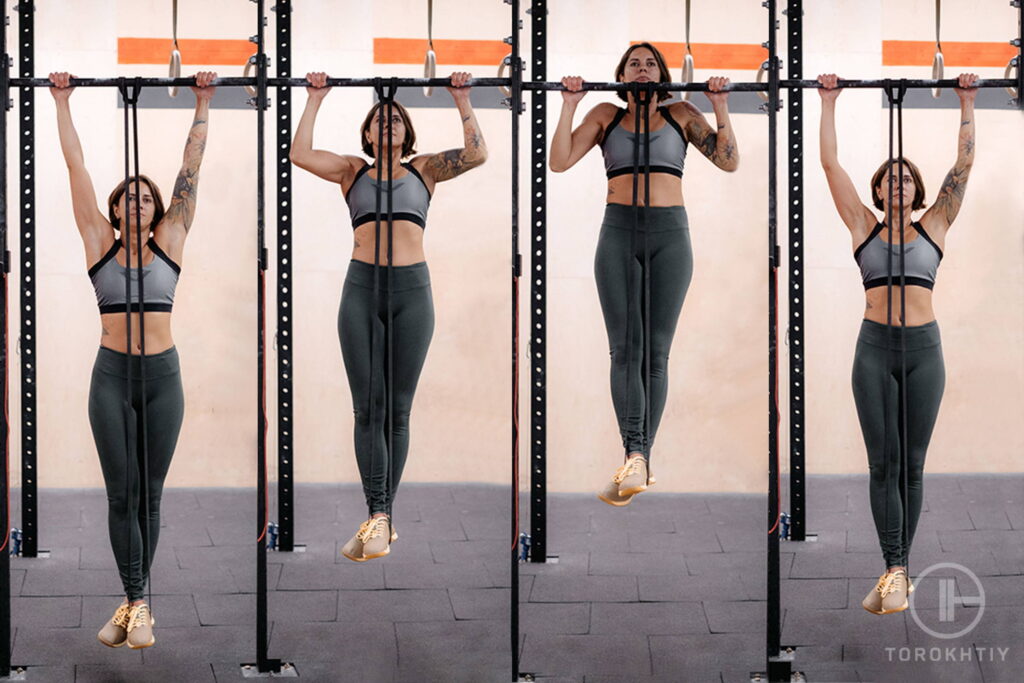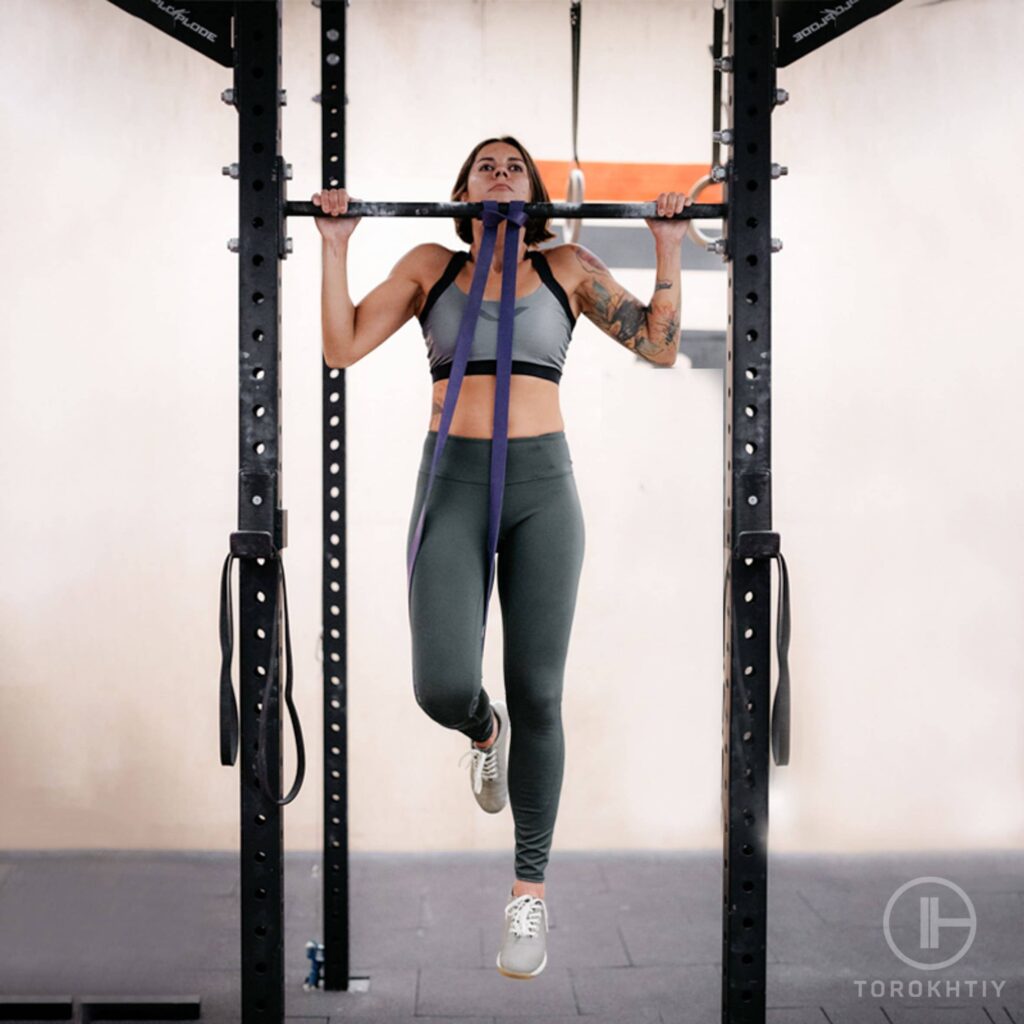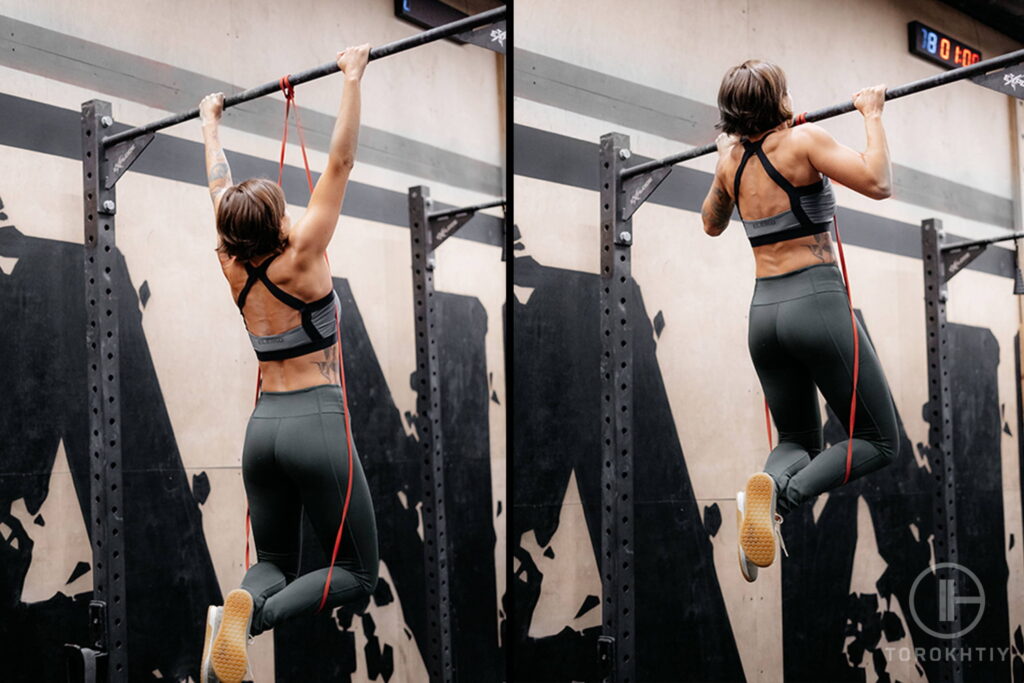Assisted Pull-Ups With Resistance Bands: How to Do It Right
Author:
Unlock your full potential by engaging with our experts and community! Have questions about your fitness journey or looking for expert advice on weightlifting techniques? Don’t hesitate — leave a comment below and Oleksiy Torokhtiy will provide a personalized answer and insights to help you reach your goals.
Torokhtiy is reader-supported. Some links are affiliate links, and we may earn a commission at no extra cost to you. See our disclosure page for details.
Pull-ups are an effective way to build upper body strength, but doing just one can already be a huge challenge for most people. Thankfully, banded pull-ups offer an easier variation to help you work your way to strict pull-ups. Let’s discuss the right way to do resistance band-assisted pull-ups.
Should you do assisted pull-ups with resistance bands? Performing pull-ups with resistance can help you gain more muscular strength and control to prepare you for bodyweight pull-ups. Here are the steps to correctly doing one:
- Get the resistance band ready
- Securely grip the bar
- Position your knees or feet on the band
- Pull yourself up
- Descend slowly in a controlled manner

What Are Banded Pull-Ups?
Occasionally, despite best attempts, people just can’t manage to complete a full strict pull-up, owing to insufficient strength, muscle mass, or motor mechanics. This is where elastic band pull-ups come in. It’s one of the pull-up regressions most frequently utilized around the world. This exercise is performed by powerlifters, weightlifters, bodybuilders participants, and fitness enthusiasts alike to help them build more upper body strength to eventually progress into strict pull-ups.
A resistance band is wrapped over the top of the pull-up bar and the feet or knees to do the assisted pull-up. This enables you to continue exercising your muscles while receiving slight help from the band at the bottom.
Banded Pull-up Benefits
Serves as a Regression Toward a Strict Pull-up
The banded pull-up is a step backward from the rigorous bodyweight pull-up. The banded pull-up can be a useful training exercise for building the raw muscle and strength required for this movement, as well as the direct motor mechanics required to perform strict pull-ups.
This is a great starting point for lifters and athletes who struggle to perform bodyweight pull-ups properly due to poor movement mechanics, weakness, and/or muscle mass.
Boosts Muscular Hypertrophy
Lifters and athletes are able to complete more repetitions than they would be able to without the band’s assistance. It has been established that the main factor influencing muscle growth and protein synthesis is increasing the number of repetitions as well as the duration under strain. This is because more repetitions per set will increase more time under load.
Athletes who are more advanced can benefit from employing elastic band pull-ups by performing repetitions that are slower and more controlled, rather than those that would otherwise be performed just using bodyweight at faster rates and perhaps with less muscular engagement.
Improves Muscular Strength and Endurance
Every athlete should be able to perform bodyweight exercises like pull-ups and push-ups in order to lay the foundation for all forms of training. No matter the sport or gender, the inability to do these rigorous pull-ups is an explicit limitation in strength and movement that should not be ignored.
After performing banded pull-ups, all athletes must master the strict pull-up in order to build the strength and muscle mass required for subsequent actions and workout progressions. Therefore, rubber band-assisted pull-ups serve as a great weapon to boost muscular strength and endurance to be able to progress to bodyweight upper body exercises.

Enhances Skill and Control
While banded pull-ups may not be a direct link to more difficult functional fitness bar exercises like body rows and muscle ups, they can undoubtedly help intermediate and advanced lifters improve their control and skill.
By providing a small amount of band assistance to athletes, the lifter will not be constrained by strength and/or muscle mass insufficiency while working to improve skill and control. Finally, by employing banded pull-ups as a step towards bar muscle ups, kipping bar pull-ups, etc., you can increase the amount of skill training accomplished, because you are able to complete more repetitions with the same load, thanks to the band’s support.

Possible Drawbacks
The fact that bands offer inconsistent support is one of the main drawbacks of resistance band-assisted pull-ups. The band’s assistance is concentrated at the bottom of the movement, reducing significantly as you lift yourself up. Beginners are unable to build strength as soon as possible because of this inconsistent assist. Therefore, it may slow down the progression for people who end up relying on resistance bands all the time.
Follow us!

Free!
Get a 2-week Weightlifting Program as a bonus for the subscription to kickstart your training plan!

Free!
How to Use Resistance Band for Pull-Ups?
Step 1: Get the Resistance Band Ready
Begin by choosing a high bar and a thick resistance band of the appropriate length. The bar should be far taller than you are.
The band should be looped over the high bar and the other end pulled through the loop. When you are hanging from the bar, the length should be adjusted so that one long loop hangs from it but without it reaching the ground. The other end that is fastened to the bar should be snug and secure.
Be aware that it could take several adjustments to acquire the right length for the band. The dangling end of the band needs to be reduced in height if you wish to wrap it around your knees.
Step 2: Securely Grip the Bar
You must use an overhand grip to hold the bar while performing assisted pull-ups. Put your hands over the bars and firmly grasp them with your palms facing outward. Your hands should be positioned somewhat farther apart than shoulder width and your arms shouldn’t be touching your ears.
Step 3: Position Your Knees or Feet on the Band
This exercise can be done by wrapping the band around your knees or feet. Stand on a stool or a box behind the band that is dangling. Then, position your knees or your feet inside the loop. The exercise can also be done by wrapping the band around just one foot or knee, however, this will offer less resistance, making the exercise even harder than it already is.
Step 4: Pull Yourself Up
Pull yourself steadily and slowly elevate to the bar. Breathe deeply to maintain your core’s engagement. Using the resistance band will help you raise yourself and pull your elbows to your sides as you rise.
Be mindful not to move in swinging or abrupt jerking actions; slow and controlled movement paves the way for muscle building. And instead of using your hips or lower body to pull yourself up, it is vital that the work is concentrated on the upper body.

Step 5: Descend Slowly
Conclude your assisted pull-up by lowering yourself gradually and steadily. Avoid releasing yourself abruptly because you run the danger of getting hurt. Avoid swinging when lowering yourself and just allow the band to provide the assistance you need as you descend.
Now, rest for two to three seconds between each repetition. If you are just starting off, make sure to not overdo it since this may do more harm than good. Listen to your body! Start with fewer reps and then increase them as your strength improves.

Which Bands to Use?
You’ll need a long resistance band first in order to perform a band-assisted pull-up effectively. If not, you’ll start off with your head over the bar, which kind of defeats the purpose of the exercise. You want one that is longer than your height when stretched out.
Additionally, you should experiment a little to find the right balance between the resistance of the band and your body weight. If the resistance is not enough to support your weight, you will not get the assistance you need.
On the other hand, if the resistance is too high, it will either not stretch out under your weight enough or it might give you too much of a lift upwards. This, in turn, will prevent you from effectively training your back, shoulders, arms, and core muscles and prevent you from progressing.
Resistance Pull-up Band We Recommend
I like reaching out for a pull-up band whenever I want to go back to the basics and train my muscle control by getting in more reps. My personal favorite is the FitLife Resistance Pull-Up Bands which I found to be a great mix of versatility and durability. This band has never snapped or broke on me, allowing me to do banded pull-ups with confidence and maximum safety.
FAQs
Do resistance band pull-ups build muscle?
Yes, the resistance band only acts as a support. The act of slowly ascending and descending in a controlled manner recruits your muscles, essentially building muscle mass, strength, and endurance.
What can replace assisted pull-ups?
If pull-ups aren’t your cup of tea but still want to target the same muscles, here are some of the alternative exercises you can do:
- Inverted rows
- Suspension trainer inverted rows
- Wide grip lat pull downs
- Bent over rows
- Lat push downs
- Lat pulldowns
- Close grip V bar pulldowns
What muscles do assisted chin-ups work?
Resistance bands for chin-ups are a great way to build strength for bodyweight chin-ups. The main muscle this exercise targets is the latissimus dorsi. Moreover, muscles that act as a synergist to assist the lats during chin-ups are the biceps brachii, brachioradialis, brachialis, triceps, infraspinatus, teres minor, teres major, lower trapezius, pectoralis major, external abdominal oblique, and erector spinae.
Conclusion
Banded pull-ups are highly beneficial if you’re trying to build muscular strength and endurance to progress to bodyweight pull-ups. It is quite challenging to begin training for pull-ups so feel free to use the detailed guide above to help you.
Any questions? Suggestions? Let us know in the comment section below!
Also read:
- Best Pull Up Assist Bands
- Bicep Exercises With Resistance Bands
- Banded Rows
- Do Resistance Bands Build Muscle
- How to Choose the Right Resistance Band
- Resistance Bands Guide
References:
- Chin Up Exercise // Physiopedia:
https://www.physio-pedia.com/Chin_Up_Exercise
Why Trust Us?
With over 20 years in Olympic weightlifting, strength training, nutrition coaching, and general fitness our team does its best to provide the audience with ultimate support and meet the needs and requirements of advanced athletes and professional lifters, as well as people who strive to open new opportunities and develop their physical capabilities with us.
By trusting the recommendations of our certified experts in coaching, nutrition, and sports training programming, as well as scientific consultants, and physiotherapists, we provide you with thorough, well-considered, and scientifically proven content. All the information given in the articles concerning workout programming, separate exercises, and athletic performance, in general, is based on verified data.
The product testing process is described in more detail here.
Author: Oleksiy Torokhtiy
Olympic Weightlifting Champion, PhD in Sport Science
Best Results: Snatch – 200 kg,
C&J – 240 kg
Oleksiy Torokhtiy is a professional athlete boasting 20 years of experience in Olympic weightlifting. With multiple European and World titles under his belt, he has showcased his prowess in two Olympic Games (Beijing 2008 and London 2012). Upon concluding his illustrious career, Oleksiy dedicated himself to coaching. By 2022, he had conducted over 200 weightlifting seminars worldwide. He is the visionary behind an international sportswear and accessories brand known for its motto, “Warm Body Cold Mind.” Additionally, he is an esteemed author and the creator of a series of training programs and eBooks.




Does it matter whether I do these with the band wrapped around my knees or my feet? I usually do it wrapped around my knees but I’m wondering if it’s better to do it one way or another.
Hi @Mia! It will only matter in a way of resistance.
On your feet it will stretch band more and make the pull-up easier. That being said you can just do more reps then.
Both ways are good as long as you challenge yourself and get stronger.